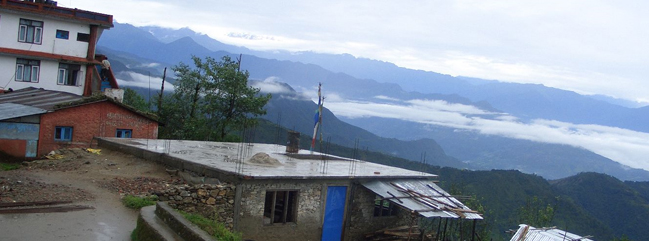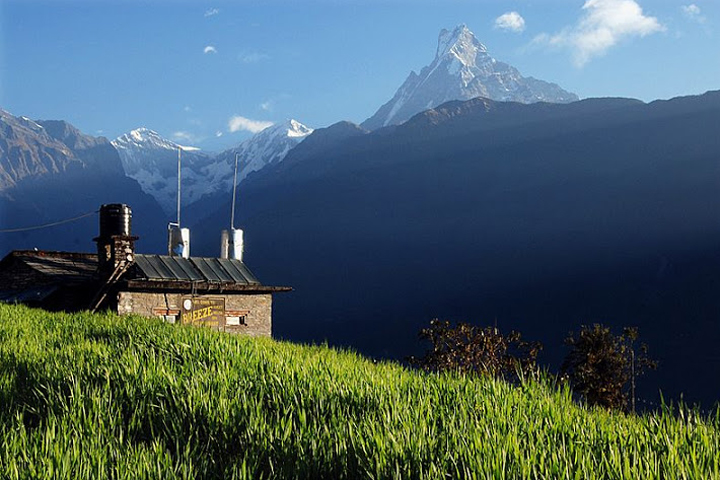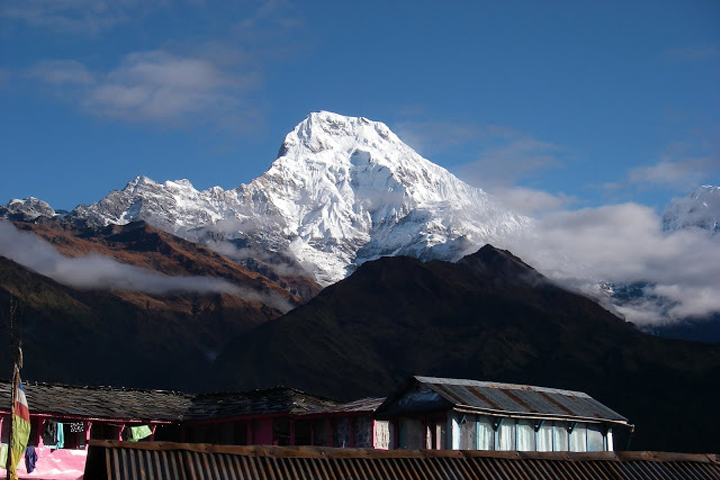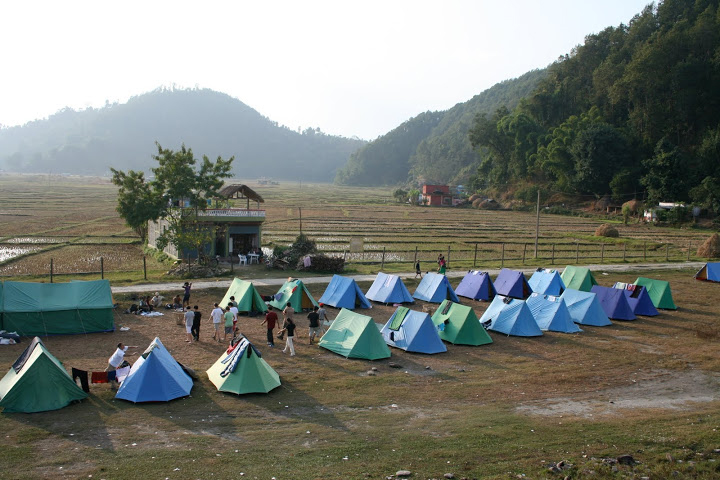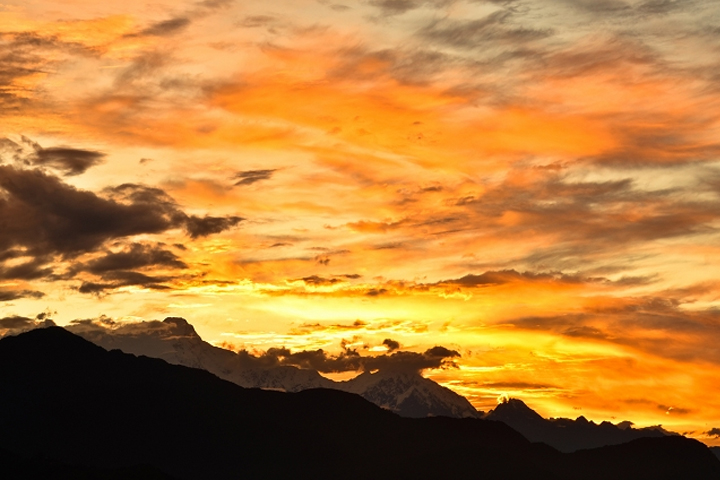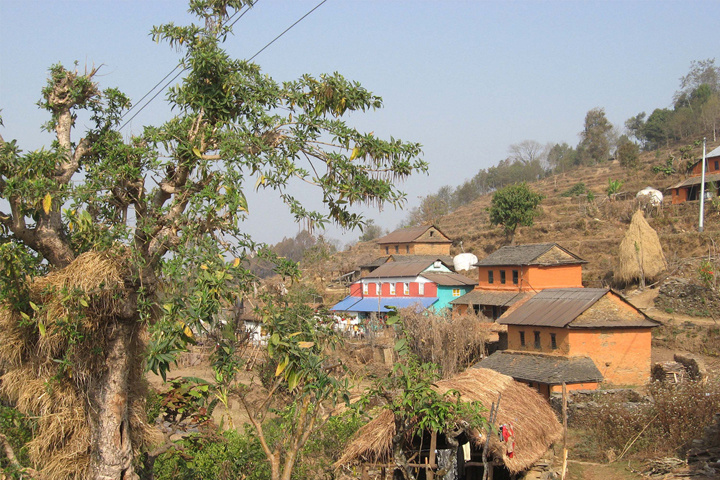The Royal Trek is one of the short trek follows a shrub like path along the foothills of Annapurna, north of the Pokhara valley. The Royal Trek is so-named because Prince Charles and his 90 person entourage had explored this route in the early eighties. This Royal Trek provides the opportunities for meaningful cultural experiences with the diverse mix of peoples and cultures that inhabit this region. The journey of Royal trek begins in the beautiful lakeside city of Pokhara passes through beautiful Gurung hamlets. In during the trek, we are able to enjoy stunning views of the eloquently built hillside rice terraces, and the magnificent Annapurna range, Machapuchhre [fishtail] and the Langtang Mountain views. The trip finally ends at the scenic Begnas Lake which is about 30 km west of Pokhara City.
The Royal trekking trip is basically recommended for beginners or those who have very limited time, because they have an opportunity to experience the unforgettable trekking holidays in the Himalaya. This Royal trek presents a true picture of uniqueness and allowing us the chance to capture the traditional lifestyles of the tribes whose ancient religious practices and traditions have remained unchanged for thousands of years.
Royal trek offers both views of City and Mountain. This is a comfortable route suitable even for the older people and to all who likes to enjoy all mix of rural social life of the mid-hill. Nepal is accompanied by beautiful view of the Annapurna massif and natural sceneries full of bio-diversity. This also provides a full picturesque view of Pokhara City.
Day 01: Arrival day in Kathmandu (1300m.)
Upon your arrival at the Tribhuvan intl. airport our representative welcomes you and assists to transfer in your hotel in Kathmandu. At the evening you’ll transfer for welcome dinner in one of the typical Nepalese restaurant with the cultural & musical programs in the heart of Kathmandu and briefing about your trip and overnight at Hotel.
Day 02: Kathmandu valley sightseeing tour
After breakfast at the hotel you will be leave for full day sightseeing tour to the world heritage sites in Kathmandu valley. Today you will visit pilgrimage sites of the Hindus temple Pashupatinath, one of the most important shrines of Shiva. Here you can see the cremating system of the Hindus most of the times in the holy riverbank of Bagmati. After that visit Nepal’s largest stupa Bouddhanath a pilgrimage centre for Buddhist. After finishing your lunch at Bouddhanath visit another Buddhist centre, Swoyambhunath stupa(monkey temple); covering wide range of area with highest point of Kathmandu valley and enjoy the 360 degrees of valley view. After exploring this spot transfer to Kathmandu Durbar Square the old royal palace of Kathmandu and can be seen lot of temple, Nepali traditional architectures and another attraction of this place is the Kumari (the living goddess). After finished your sightseeing trip you will be transferred to your hotel. Overnight at the hotel.
Day 03: Drive from Kathmandu to Pokhara valley (823m/2,700ft), 7-8 hrs drive
With a morning wake up guide will pick up you and transfer to the tourist bus station and drive (approximately six hours with breaks) through the beautiful river view & Nepalese countryside to reach the Pokhara lakeside and transfer to the hotel and rest of the time explore the surrounding lakeside areas and overnight at hotel.
Day 04: Pokhara to Kalikasthan (1,370m/4,496ft)
Today, after breakfast drive to Bijayapur Khola(trek starting point) and begin our trek. Initially we start our walk for about an hour through flat paddy fields and cross the river. After crossing the river the trail starts to ascend to Kalikasthan. Lunch will be served midway through the climb. After arriving at Kalikasthan, we rest for some time and after that explore the surrounding areas and overnight at teahouse.
Day 05: Kalikasthan to Syaklung (1,730m/5,675ft)
After breakfast we start walking through the villages. We walk along the ridge of the mountain with good views of Annapurna and Lamjung Himal. Today we can explore many villages and the rhododendron forests. Overnight at Syaklung.
Day 06: Syaklung to Chisapani (1550m/5,084ft)
Walk through the Gurung village, rhododendron and Sal forest. Half way through the walk there is a 400m descent, then a 600m ascent to arrive at Chisapani. This is the best view point at which to see the Himalayan Panorama. You will see Dhaulagiri to the west of Annapurna.
Day 07: Chisapani to Pokhara
Today we walk half way down the hill to Rupatal and climb about 200 meters to arrive at Sundare Danda. Walk 15 minutes down to Begnas Tal for an hour boating to catch the transfer to Pokhara and on arrival at hotel check in and rest of the time explore the lake side and overnight at hotel.
Day 08: Drive from Pokhara to Kathmandu, 7-8 hrs drive
Morning we’ll drive back through the scenic countryside and en route will stop for breakfast & lunch. It takes 7 hours back to Kathmandu. On arrival at Kathmandu guide will transfer to the hotel and rest of the day relax or explore the surrounding areas and overnight at hotel.
Day 09: Departure
Today is free or last minute shopping for souvenirs or gift to your family, friends or relatives for you until your departure flight/drive or to commence any extra trips or activities you may have booked with us. If departing, you’ll be transferred to the International airport for your departure flight to your onwards destination.
NOTE: The above information is a guide and standard template of what we provide. The trek can be customized at your request to accommodate your specific requirements.
Note : On adventure trips of this type, weather, local politics, transport or a multitude of other factors beyond our control can result in a change of itinerary. It is, however, very unlikely that the itinerary would be substantially altered; if alterations are necessary the leader will decide what is the best alternative, taking into consideration the best interests of the whole group. Where a change does occur, we do everything we can to minimize its effect, but we cannot be responsible for the results of changes or delays.
Q.What type of shape do I need to be in, is this trip for me?
A. Trekking is suitable for average people who are moderately fit, thus no previous experience is required. Some physical fitness programs such as running, swimming, hiking is recommended before you embark on your journey. Persons suffering from a pre-existing medical condition or disease must seek medical advice before considering the trek. Whilst on the trek, it is common to experience some discomfort before being fully acclimatized.
To prepare for a strenuous trek you should begin training at least two to three months before your departure. As a guideline, an hour of aerobic exercise three to four times per week would be considered a minimum requirement. The best preparation is bushwalking involving relatively steep ascents and descents. If you can manage a couple of valley floor to ridgeline ascents per comfortable and able to enjoy the trek to the fullest. They are physically strong, sharp-witted and have an incredibly positive attitude towards a life that we would consider extremely tough. There is something about a trek in the Himalaya that draws you back time and time again. For keen walkers it is a paradise and even avowed non-walkers find that one foot just seems to follow the other, drawn by the appeal of what lies beyond.
Q. Will somebody come to pick me up at the Airport upon my arrival?
A. Yes, our Airport Representative will be there to greet you outside of Terminal Hall, he/she will be displaying an Kiwi Adventures Treks & Expedition sign board. Upon arrival, you will be transferred to your hotel.
Q. What sort of accommodation can I expect in Kathmandu and in trekking?
A. 11 night’s Trekking Guesthouse, 4 nights three/four star hotels in Kathmandu.
We use standard rooms from three/four star hotels in Kathmandu with breakfast included. Along the trekking routes teahouses/Lodges generally provide basic clean facilities with a mattress and a quilt or blanket. We can also offer you sleeping bags if needed (which need to return after the trip) but it is a good idea to always have your own sleeping equipment. We usually provide single and double rooms as well as the occasional dormitory. The dining room is downstairs around a fire. All food will be cooked to order in the little kitchen. You should not enter the kitchen unless asked to do so.
Q. What sort of food can I expect in trekking?
A. In trekking most teahouses (lodges) cook a delicious range of mostly vegetarian fare. Pasta, tuna bakes, noodles, potatoes, eggs, dhal bhat, bread, soups, fresh vegetables (variety depends on the season) and even some desserts like apple pies, pancakes, and some interesting attempts at custard. You will find a lot of garlic on the menu because it assists with acclimatization – eat some every day. In many larger villages you may find some meat on the menu. You can always get hot chocolate, tea, and hot lemon drinks, as well as soft drinks, and treats like chocolate and crisps.
Each day dinner and breakfast are used to take in the same lodge you spend the night. Lunch will be taken on the way to destination.
Q. What sort of transportation you use?
A. Kiwi Adventures Treks & Expedition is all about providing you with local insights as well as adventure, with that in mind, where we think you will get more out of your holiday by using different means of transport that is what we do. Using a variety of private transport is an integral part of our Himalaya tours and enhances the experience!
We use private tourist vehicles for sightseeing, city tours and pickups. Depending on the group size we use cars, minibus, van or land cruiser. These small light vehicles are more manoeuvrable and flexible enabling us to take you through the Narrow roads of Nepal. All the vehicles are usually air-conditioned unless we are travelling in cooler areas.
Q. What is the best season for this trekking?
A. Our trekking season extends from mid- September to May. From early September the monsoonal rains decrease. By end of September through to December the weather is usually stable with mild to warm days, cold nights. February, March, April, May, October, November, December are the best time to do trek.
Q. What is the weather & temperature like in trekking?
A. Weather in the mountains is notoriously difficult to predict. At night it is generally cooler the days are generally warm. Winter (January and February) will be bit colder but the days can be quite beautiful and warm if the sun is out. There will be bit of snow during the month of January, February and December. It is also important to make sure that you can stay warm and dry in just about any conditions. Expect the unexpected! The temperature could be as high as 20 deg C to -15 deg C low.
Q. Can I charge my digital camera or other batteries on my trip?
A. These facilities will be available in most of the places in your hotel reception by paying some service charges. Remember to bring your adapters!
Q. Is there any communication while we are on trekking?
A. There are telephones in some villages along the trekking routes from which you can make international calls.
Q. Can I use credit cards in the places visit in trekking?
A. In most cities yes, to some extent, however once you leave those cities behind, all you need is cash.
Q. How much additional money do I need per day?
A. In Kathmandu, you can allocate US$ 10 – 25 for a lunch / dinner. It’s all depends on your spending habits. US$7 to 10 US$ a day will be enough to buy bottles of water, chocolates and few drinks in trekking.
Q. Do I need to tip my guide and porters? How much would that be?
A. This is a difficult thing to gauge. We have seen everything from 20USD to 1000 USD per person for guides and porters. Tipping is not required, but a small way to show your guides and local porters thanks for their help. The level of the tip should reflect the level of personal involvement with your guide.
Q. Is the water OK to drink? Do I need to bring purifying tablets/filter?
A. In most places bottled water is readily available. If you wish to drink normal water, you need to use purifying aid, which you will need to bring with you.
Q. Are the Kiwi Adventures Treks & Expedition staff insured?
A. Our company insures all our trekking staff, including guide, cook, sherpa and porters.
Q. What essential documents do I need to bring with me on tour?
A. *Valid Passport – must be valid for up to 6 months after you return from your tour, keep a separate photocopy.
*Travel insurance, keep a separate photocopy
*Cash and Traveller’s Cheques, keep numbers and proof of purchase separate
*Flight tickets
*Emergency contact numbers for T/C’s, banks, insurance, family contacts.
Q. Can I add extra days to my trekking trip?
A. A hoilday should never be about making it to the final point quickly. Along your trek we can add days at your request with additional costs to cover guides, porters, accommodation and food.
Q. Do you use yaks/porters on the trek or do we carry all of our own gear?
A. Whilst on the trek, our porter will take care of your luggage. All you need to carry is your small day bag for your personal belongings like camera, water bottle, sun cream etc only.
Q. What opportunities will I have for shower along the trek?
A. In major places, we arrange guesthouse with hot shower. And in rest of the places, hotel water in bucket will be provided for shower; it would cost you extra about USD 3-4 per shower.
Q. Do you know about how many total miles the trek is?
A. Total distance of the entire trek is about 75 miles.
Cost Includes
• Airport / Hotel / Airport pick up & drop by private car / van / bus.
• Standard twin sharing accommodation in three/four star hotel in Kathmandu breakfast included.
• Standard twin sharing accommodation in two/three star hotel in Pokhara breakfast included.
• Sightseeing/Monument entrance fees in Kathmandu and Pokhara.
• Guided city tour in Kathmandu and Pokhara by private car / van / bus.
• All your standard Meals during the trek.
• Twin sharing Lodges, Guesthouses accommodation during the trek
• Local Ace the Himalaya licensed English speaking Guide.
• The required number of local staff and Porters to carry your luggage during the trek.
• Food, accommodation, salary, insurance, equipment and medicine for all staff.
• Annapurna conservation Park permits.
• Surface transfer from and to Kathmandu.
• All our government taxes.
• Official expense.
Cost Excludes
• Lunch and dinner whilst in Kathmandu and Pokhara .
• Your travel insurance (compulsory, please contact us if you wish to sign up for the Global Rescue membership plan).
• International airfare and airport departure tax.
• Nepal entry visa, you can obtain a visa easily upon your arrival at Tribhuwan International Airport in Kathmandu. (Tourist Visa with Multiple Entry for 30 days can be obtained by paying US $ 40 or equivalent foreign currency. Similarly, Tourist Visa with Multiple Entry for 90 days can be obtained by paying US $ 100. You will also require 2 passport size photos.)
• Alcoholic, hot and cold drinks.
• Personal trekking Equipment.
• Tips for trekking staff. (Tipping is expected).
• Any others expenses which are not mentioned on Price Includes section.
